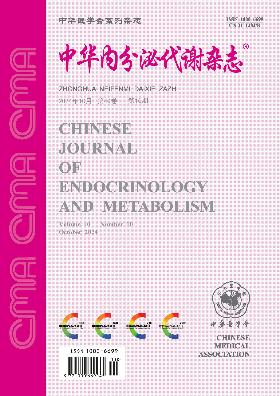Two cases of autoimmune polyendocrine syndrome type I caused by AIRE gene mutation
Q4 Medicine
引用次数: 0
Abstract
Objective Autoimmune polyendocrine syndrome type Ⅰ(APS-Ⅰ) is caused by mutations in the autoimmune regulator gene (AIRE) gene. In this study, phenotype and AIRE gene analysis were performed in two patients with APS-Ⅰ. Methods Peripheral blood samples were collected from two patients with APS-Ⅰ and their families. All exons of the AIRE gene and adjacent exon-intron sequences were amplified by PCR and subsequently sequenced. The silico analysis was performed to predict the possible impact of the mutations on the function of the AIRE protein. At the same time, 100 healthy controls were selected to confirm the mutation. Results Case 1 was a 31-year-old female who exhibited chronic mucocutaneous candidiasis, hypoparathyroidism, Addison′s disease, Hashimoto′s thyroiditis, and premature ovarian failure. A homozygous c. 483_484insC mutation in exon 4 of AIRE gene was identified in this patient. Her parents, siblings and son were heterozygous for this mutation, which is consistent with the autosomal recessive inheritance pattern. Case 2 was a 34-year-old male who had mucocutaneous candidiasis, Addison′s disease, primary hypoparathyroidism, and Hashimoto′s thyroiditis. A compound heterozygous AIRE mutation (c.179A>G/C.463+ 2T>C) were identified in this patient. His father was heterozygous for c. 179A>G mutation, and his mother was heterozygous for C. 463+ 2T>C, which is consistent with autosomal recessive inheritance mode. The c. 483_484insC and c. 463+ 2T>C have been reported to be pathogenic. The c. 179A>G mutation was predicted pathogenic by SIFT and PolyPhen2 software, which was not detected in 100 healthy controls. It has not been reported in the HGDM database and is a novel mutation. Conclusion We identified a novel AIRE gene mutation (c.179A>G), which contributed to further understanding of the pathogenesis of APS-Ⅰ. The clinical variation and rarity of APS-Ⅰ makes the syndrome hard to recognize. Early recognition of symptoms and screening for AIRE mutation in patients with APS-Ⅰ has important clinical implications for the diagnosis and treatment. Key words: Autoimmune polyendocrine syndrome type Ⅰ; AIRE gene; MutationAIRE基因突变致自身免疫性多内分泌综合征I型2例
目的自身免疫性多内分泌综合征Ⅰ(APS-Ⅰ)是由自身免疫调节基因(AIRE)基因突变引起的。本研究对2例APS-Ⅰ患者进行了表型和AIRE基因分析。方法采集2例APS-Ⅰ患者及其家属外周血标本。AIRE基因的所有外显子和邻近的外显子-内含子序列通过PCR扩增并随后测序。进行硅分析以预测突变对AIRE蛋白功能的可能影响。同时,选择100名健康对照来证实突变。结果病例1为31岁女性,表现为慢性皮肤黏液念珠菌病、甲状旁腺功能减退、Addison病、桥本甲状腺炎和卵巢早衰。在该患者中发现AIRE基因外显子4纯合子c. 483_484insC突变。其父母、兄弟姐妹和儿子为杂合突变,符合常染色体隐性遗传模式。病例2为34岁男性,患有皮肤黏液念珠菌病、Addison病、原发性甲状旁腺功能低下和桥本甲状腺炎。一个复合杂合AIRE突变(C. 179a >G/C)。在该患者中发现463+ 2T>C)。父亲为c. 179A>G突变杂合,母亲为c. 463+ 2T> c杂合,符合常染色体隐性遗传模式。据报道,c. 483_484insC和c. 463+ 2t> c具有致病性。采用SIFT和PolyPhen2软件预测了c. 179A >g突变的致病性,该突变在100名健康对照中未检测到。它在HGDM数据库中尚未报道,是一种新的突变。结论发现了一种新的AIRE基因突变(c.179A>G),有助于进一步了解APS-Ⅰ的发病机制。APS-Ⅰ的临床变异和罕见性使得该综合征难以识别。APS-Ⅰ患者的早期症状识别和AIRE突变筛查对诊断和治疗具有重要的临床意义。关键词:自身免疫性多内分泌综合征Ⅰ;亚耳河基因;突变
本文章由计算机程序翻译,如有差异,请以英文原文为准。
求助全文
约1分钟内获得全文
求助全文
来源期刊

中华内分泌代谢杂志
Medicine-Endocrinology, Diabetes and Metabolism
CiteScore
0.60
自引率
0.00%
发文量
7243
期刊介绍:
The Chinese Journal of Endocrinology and Metabolism was founded in July 1985. It is a senior academic journal in the field of endocrinology and metabolism sponsored by the Chinese Medical Association. The journal aims to be the "Chinese broadcaster of new knowledge on endocrinology and metabolism worldwide". It reports leading scientific research results and clinical diagnosis and treatment experience in endocrinology and metabolism and related fields, as well as basic theoretical research that has a guiding role in endocrinology and metabolism clinics and is closely integrated with clinics. The journal is a core journal of Chinese science and technology (a statistical source journal of Chinese science and technology papers), and is included in Chinese and foreign statistical source journal databases such as the Chinese Science and Technology Papers and Citation Database, Chemical Abstracts, and Scopus.
 求助内容:
求助内容: 应助结果提醒方式:
应助结果提醒方式:


